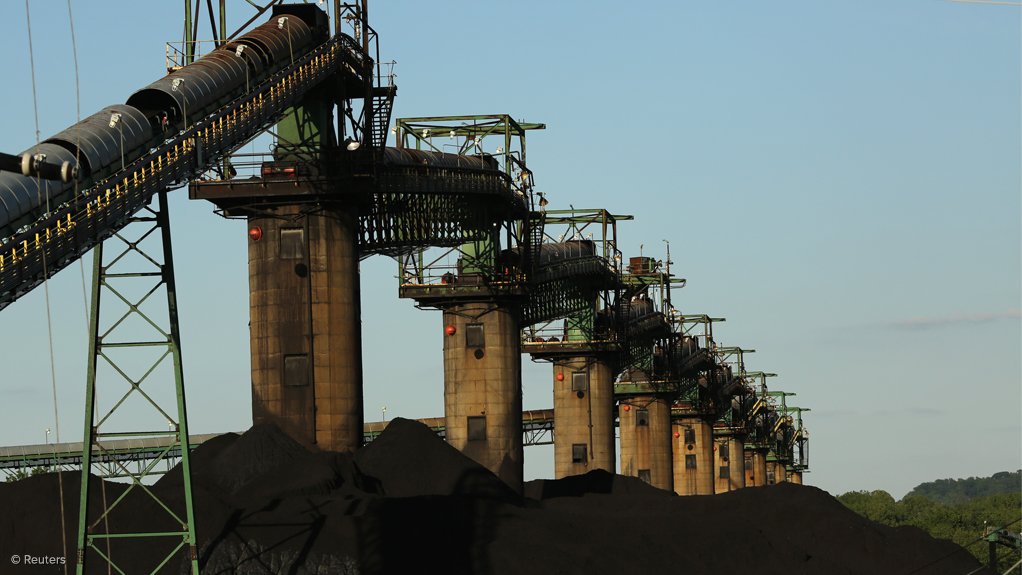TORONTO (miningweekly.com) – With nearly all of the once-major US coal companies having filed for Chapter 11 bankruptcy protection as a result of low prices, ratings agency Moody’s Investors Service on Friday stated in its latest North American Coal Outlook that the stage was set for the US coal industry to emerge looking rather different.
Low prices for steelmaking metallurgical coal and electricity-generating thermal coal, caused by a supply glut, lower demand, tighter environmental policies, cheap natural gas and growing contributions from alternative energy sources had pushed major producers, including Peabody Energy, Arch Coal and Alpha Natural Resources, to go through the Chapter 11 reorganisation process.
Moody’s believed that this would see many mines closed and production rationalised to more closely match the new level of coal demand, which would help support some domestic thermal price recovery.
One of the key differences would be significant debt reduction for the industry. Moody’s advised that Alpha had entered the reorganisation with $691-million debtor-in-possession (DIP) facilities while, pre-petition, Alpha carried $4-billion in debt and $1.7-billion in legacy liabilities, including pensions, post-retirement medical and asset retirement obligations.
Peabody had arranged for roughly $800-million in DIP financing, relative to pre-petition debt of over $6-billion, plus $1.4-billion of legacy liabilities. Arch’s DIP was roughly $275-million in size, while its pre-petition debt was $5-billion, plus roughly $550-million in legacy costs. “Based on earnings generation prior to filing, and deteriorating industry conditions, we believe that, post emergence, these companies can support, at most, a quarter of their pre-bankruptcy long-term obligations,” said Moody’s analysts.
NEXT ITERATION
According to Moody’s, Arch, Alpha and Peabody would emerge dominant players, with lower-cost mines and better capitalised balance sheets putting the remaining smaller miners at a relative disadvantage, absent of similar debt restructuring.
“We believe that many mines will be closed and debt burdens will be reduced to a fraction of pre-filing amounts. Overall, we expect the industry to be more consolidated post restructuring, with better cost structures and lower leverage. Larger, more diversified companies with conservative balance sheets post restructuring will have an advantage relative to smaller ones,” reported the ratings agency.
Moody’s added that most asset-retirement obligations were likely to survive the bankruptcy proceedings, potentially reducing recovery for the creditors. Post-retirement obligations to workers would also likely be pared down in bankruptcy, although Moody’s did not expect the dramatic cut seen with Patriot Coal's bankruptcy filing in 2012, when the company shed almost all of its $1.4-billion of other post-retirement obligations.
On the other hand, pension obligations were typically preserved through the bankruptcy process, analysts noted.
Further, the agency advised that self-bonding requirements would become subject to enhanced scrutiny by the regulators, as the US faced an unprecedented number of mine closures. Coal asset-retirement obligations were likely to significantly depress asset valuations.
For example, in April 2016, SunCoke Energy paid $10-million to divest of its coal business, which included significant reclamation liabilities.
“We believe coal will remain an important component of the nation’s fuel mix. That said, we do not believe additional coal-fired power plants will be built, and we expect that any growth in electric generation will be captured by natural gas and renewable energy sources.
“Overall, we expect the coal industry to be more consolidated post restructuring, with better cost structures and lower leverage. Larger, more diversified companies with conservative balance sheets post restructuring will have an advantage relative to smaller players, as they will likely enjoy access to a more stable and higher-rated customer base, as well as more operational flexibility in responding to price volatility, transportation disruptions and regulatory risks,” stated Moody’s.
DIM OUTLOOK
On January 21, Moody’s had placed 55 companies in the base metal, precious metal, iron-ore and coal industries – rated between A1 and B3 – under review for downgrade. This wholesale recalibration of ratings included nine coal-related companies, based on the agency's belief that the industry had undergone a long-term structural decline, with little prospect for near-term recovery.
Moody’s stated that the US thermal coal industry was challenged by weak natural gas prices and continued regulatory pressure. While coal consumption would decline moderately by 4% to 711-million short tons in 2016, representing 32% of the fuel mix, coal output would take another 12% cut to 784-million short tons, as utilities used up unusually high inventories and producers shut mines and curtailed production.
Moody’s expected the seaborne coal markets to continue to face weak prices and persistent oversupply over the next 12 to 18 months. US coal exports declined by roughly 25% to 74-million short tons in 2015, and were projected to fall by another 20% in 2016, according to the US Energy Information Agency.
“We do not anticipate a material recovery in metallurgical coal prices for the foreseeable future, due to our expectation of continued slowing Chinese demand and weak global steel production. US coal miners will produce roughly 53-million short tons of met coal in 2016, a 20% decline from 2015. We believe met coal production in the US will continue to decline, as US producers remain disadvantaged by the strong US dollar and high costs relative to Australian and Canadian miners,” Moody’s advised.
Edited by: Samantha Herbst
Creamer Media Deputy Editor
EMAIL THIS ARTICLE SAVE THIS ARTICLE
To subscribe email subscriptions@creamermedia.co.za or click here
To advertise email advertising@creamermedia.co.za or click here













